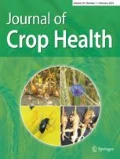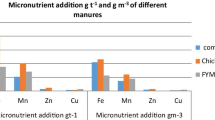Abstract
The two-location field experiment was conducted to investigate the effect of Thiobacillus and different levels of sulfur fertilizer on growth and physiological indices in the replacement intercropping of sesame and mung bean. A factorial experiment was performed based on a randomized complete block design in 3 replications in 2018. The experimental factors consisted of cropping ratio at five levels: 1. sesame sole cropping, 2. mung bean sole cropping, 3. 75% sesame +25% mung bean (3:1), 4. 50% sesame +50% mung bean (1:1), 5. 25% sesame +75% mung bean (1:3). Sulfur fertilizer was used at three levels: control level (S0), 50% of recommended amount (S1), 100% of recommended amount (S2). Thiobacillus bacteria was used at two levels: T0 and T1. The results showed that growth indices chlorophyll a, chlorophyll b, total chlorophyll, biological yield, and grain yield of sesame and mung bean were significantly affected by the studied treatments. The highest growth indices, chlorophyll a, chlorophyll b, total chlorophyll, biological yield and grain yield of sesame were obtained by the 3:1 ratio. For the mung bean, the highest growth indices, chlorophyll a, biological yield, grain yield were obtained by mung bean sole cropping and the highest chlorophyll b and total chlorophyll were obtained by the 1:1 ratio. Also, sulfur fertilizer, 100% of the recommended amount, increased all studied indices in both plants except for chlorophyll a in sesame. Interaction effects of cropping ratio and location on growth indices, grain biological yield, chlorophyll a of sesame and mung bean were significant.
Zusammenfassung
Das Feldexperiment wurde durchgeführt, um die Wirkung von Thiobacillus und verschiedenen Mengen an Schwefeldünger auf Wachstums- und physiologische Indizes im Zwischenfruchtanbau von Sesam und Mungbohne zu untersuchen. Es wurde ein faktorieller Versuch basierend auf einem randomisierten vollständigen Blockdesign in 3 Wiederholungen im Jahr 2018 durchgeführt. Die Versuchsfaktoren bestanden aus dem Anbauverhältnis in fünf Stufen: 1. Sesam-Alleinanbau, 2. Mungbohnen-Alleinanbau, 3. 75 % Sesam +25 % Mungbohne (3:1), 4. 50 % Sesam +50 % Mungbohne (1:1), 5. 25 % Sesam +75 % Mungbohne (1:3). Schwefeldünger wurde in drei Stufen verwendet: Kontrollstufe (S0), 50 % der empfohlenen Menge (S1), 100 % der empfohlenen Menge (S2). Thiobacillus-Bakterien wurden in zwei Stufen eingesetzt: T0 und T1. Die Ergebnisse zeigten, dass die Wachstumsindizes Chlorophyll a, Chlorophyll b, Gesamtchlorophyll, der biologische Ertrag und der Kornertrag von Sesam und Mungbohnen durch die untersuchten Behandlungen signifikant beeinflusst wurden. Die besten Wachstumsindizes und die höchsten Werte für Chlorophyll a, Chlorophyll b, Gesamtchlorophyll, biologischen Ertrag und Kornertrag von Sesam wurden durch das Verhältnis 3:1 erreicht. Bei der Mungbohne wurden die besten Wachstumsindizes und höchsten Werte für Chlorophyll a, biologischen Ertrag und Kornertrag durch den Mungbohnen-Alleinanbau erreicht, der höchste Chlorophyll-b- und Gesamtchlorophyllwert durch das 1:1-Verhältnis. Auch Schwefeldünger (100 % der empfohlenen Menge) erhöhte alle untersuchten Indizes in beiden Pflanzen, außer Chlorophyll a in Sesam. Die Interaktionseffekte des Anbauverhältnisses und des Standorts auf die Wachstumsindizes, den biologischen Kornertrag, das Chlorophyll a von Sesam und Mungbohnen waren signifikant.













Similar content being viewed by others
References
Cited Literature
Adhikary B, Pandey B (2007) Response of sulphur on maize production in acid soils of Rampur Chitwan. Inst Agric Anim Sci J 28:49–55
Awal M, Koshi H, Ikeda T (2006) Radiation interception and use by maize/peanut intercrop canopy. Agric For Meteorol 139:74–83
Banik P, Midya A, Sarkar B, Ghose S (2006) Wheat and chickpea intercropping systems in an additive series experiment: advantages and weed smothering. Eur J Agron 24:325–332
Baumann D, Bastiaans L, Goudriaan J, Van Laar H, Kropff M (2002) Analysing crop yield and plant quality in an intercropping system using an eco-physiological model for interplant competition. Agric Syst 73:173–203
Besharati H, Khosravi H, Khavazi K, Ziaeian A, Mirzashahi K, Ghaderi J, Zabihi HR, Mostashari M, Sabah A, Rashidi N (2017) Effects of biological oxidation of sulfur on soil properties and nutrient availability in some soils of Iran. Iran J Soil Res 31(3):393–403
Bhatti IH, Ahmad R, Jabbar A, Nazir M, Mahmood T (2006) Competitive behaviour of component crops in different sesame-legume intercropping systems. Int J Agric Biol 8(2):165–167
Eddowes M (1969) Physiological studies of competition in Zea mays L: I. Vegetative growth and ear development in maize. J Agric Sci 72:185–193
Fenández-Aparicio M, Sillero JC, Rubiales D (2007) Intercropping with cereals reduces infection by Orobanche crenata in legumes. Crop Prot 26:1166–1172
Gao Y, Duan A, Qiu X, Sun J, Zhang J, Liu H, Wang H (2010) Distribution and use efficiency of photosynthetically active radiation in strip intercropping of maize and soybean. Agron J 102:1149–1157
Ghosh P (2004) Growth, yield, competition and economics of groundnut/cereal fodder intercropping systems in the semi-arid tropics of India. Field Crops Res 88:227–237
Ghosh P, Mohanty M, Bandyopadhyay K, Painuli D, Misra A (2006) Growth, competition, yield advantage and economics in soybean/pigeonpea intercropping system in semi-arid tropics of India: I. Effect of subsoiling. Field Crops Res 96:80–89
Hauggaard-Nielsen H, Ambus P, Jensen ES (2001) Interspecific competition, N use and interference with weeds in pea–barley intercropping. Field Crops Res 70:101–109
Kandhro M, Tunio S, Memon H, Ansari M (2007) Growth and yield of sunflower under influence of mungbean intercropping. Pak J Agric Agric Eng Vet Sci 23(1):9–13
Kertesz MA, Mirleau P (2004) The role of soil microbes in plant sulphur nutrition. J Exp Bot 55:1939–1945
Kobata T, Moriwaki N (1990) Grain growth rate as a function of dry-matter production rate: an experiment with two rice cultivars under different radiation environments. Jpn J Crop Sci 59:1–7
Kouchaki AR, Nasiri MM, Feizi H, Amir MS, Mandani F (2010) Effect of strip intercropping of maize (zea mays l.) and bean (phaseolus vulgaris l.) on yield and land equivalent ratio in weedy and weed free conditions. Agroecology 2(2):225–235
Langham DR (2007) Phenology of sesame. In: Janick J, Whipkey A (eds) New crops and new uses. ASHS, Alexandria, pp 144–182
Li C‑J et al (2011) Crop nitrogen use and soil mineral nitrogen accumulation under different crop combinations and patterns of strip intercropping in northwest China. Plant Soil 342:221–231
Lichtenthaler HK (1987) Chlorophylls and carotenoids; pigments of photosynthetic membranes. Methods Enzymol 148:350–382
Lindquist JL, Mortensen DA (1999) Ecophysiological characteristics of four maize hybrids and Abutilon theophrasti. Weed Res 39:271–285
Lithourgidis A, Vasilakoglou I, Dhima K, Dordas C, Yiakoulaki M (2006) Forage yield and quality of common vetch mixtures with oat and triticale in two seeding ratios. Field Crops Res 99:106–113
Maffei M, Mucciarelli M (2003) Essential oil yield in peppermint/soybean strip intercropping. Field Crops Res 84:229–240
Marschner H (1995) Mineral nutrition of higher plants, 2nd edn. Academic Press, New York, pp 15–22
Mirhashemi SM, Kouchaki AR, Parsa M, Nasiri MM (2009) Evaluating the benefit of ajowan and fenugreek intercropping in different levels of manure and planting pattern. Iran J Field Crops Res 7(1):271–281
Muoneke C, Mbah E (2007) Productivity of cassava/okra intercropping systems as influenced by okra planting density. Afr J Agric Res 2:223–231
Mushagalusa GN, Ledent J‑F, Draye X (2008) Shoot and root competition in potato/maize intercropping: effects on growth and yield. Environ Exp Bot 64:180–188
Pandita A, Shah M, Bali AS (2000) Effect of row ratio in cereal-legume intercropping systems on productivity and competition functions under Kashmir conditions. Indian J Agron 45:48–53
Pouramir F, Nasiri Mahallati M, Koocheki A, Ghorbani R (2010) Assessment of sesame and chickpea yield and yield components in the replacement series intercropping. Iran J Field Crops Res 8:747–757
Ravi S, Channal H, Hebsur N, Dharmatti P (2010) Effect of sulphur, zinc and iron nutrition on growth, yield, nutrient uptake and quality of safflower (Carthamus tinctorius L.). Karnataka J Agric Sci 21(3):382–385
Sangale P, Patil G, Daftardar S (1981) Effect of foliar application of zinc, iron and boron on yield of safflower. J Maharashtra Agric Univ 6(1):65–66
Shinde D, Kadam R, Jadhav A (2004) Effects of sulphur oxidizing micro-organisms on growth of soybean. J Maharashtra Agric Univ 29:305–307
Tavassoli A, Ghanbari A, Ramazan D, Mousavi NS (2010) Effect of organic and inorganic fertilizers on quantitative and qualitative characteristics of pearl millet (panicum miliaceum l.) and red bean (phaseolus vulgaris l.) in intercropping. J Crop Ecophysiol (Agric Sci) 4(15):1–15
Tsubo M, Walker S, Mukhala E (2001) Comparisons of radiation use efficiency of mono-/inter-cropping systems with different row orientations. Field Crops Res 71:17–29
Tsubo M, Walker S, Ogindo H (2005) A simulation model of cereal–legume intercropping systems for semi-arid regions: I. Model development. Field Crops Res 93:10–22
Wang Y, Wang S, Cui X, Chen Z, Schnug E, Haneklau S (2003) Effects of sulphur supply on the morphology of shoots and roots of alfalfa (Medicago sativa L.). Grass Forage Sci 58:160–167
Wells R (1991) Soybean growth response to plant density: relationships among canopy photosynthesis, leaf area, and light interception. Crop Sci 31:755–761
Wenxue L, Long L, Jianhao S, Tianwen G, Fusuo Z (2004) Effects of intercropping and nitrogen application on nitrate present in the profile of an Orthic Anthrosol in Northwest China. Agric Ecosys Environ 105:483–491
Zaefarian F, Aghaalikhani M, Rezvani M, Mashhadi H, Zand E (2010) Morphological traits of corn and soybean in simultaneous competition of redroot pigweed and jimsonweed. In: Iranian Society of Weed Science (ed) Proceedings of 3rd Iranian Weed Science Congress, Volume 1: Weed biology and ecophysiology Babolsar, Iran, 17–18 February 2010, pp 487–491
Zhang NN, Sun YM, Li L, Wang ET, Chen WX, Yuan HL (2010) Effects of intercropping and Rhizobium inoculation on yield and rhizosphere bacterial community of faba bean (Vicia faba L.). Biol Fertil Soils 46:625–639
Further Reading
Dai C‑C, Chen Y, Wang X‑X, Li P‑D (2013) Effects of intercropping of peanut with the medicinal plant Atractylodes lancea on soil microecology and peanut yield in subtropical China. Agrofor Syst 87:417–426
Li W et al (2005) Effects of intercropping and nitrogen application on nitrate present in the profile of an Orthic Anthrosol in Northwest China. Agric Ecosyst Environ 105:483–491
Weil RR, McFadden ME (1991) Fertility and weed stress effects on performance of maize/soybean intercrop. Agron J 83:717–721
Author information
Authors and Affiliations
Corresponding author
Ethics declarations
Conflict of interest
A. Gilani, H. Abbasdokht and A. Gholami declare that they have no competing interests.
Rights and permissions
About this article
Cite this article
Gilani, A., Abbasdokht, H. & Gholami, A. Effects of Thiobacillus and Different Levels of Sulfur Fertilizer on Growth and Physiological Indices in Intercropping of Sesame (Sesamum Indicum L.) and Mung Bean (Vigna Radiata L.). Gesunde Pflanzen 73, 317–333 (2021). https://doi.org/10.1007/s10343-021-00554-6
Received:
Accepted:
Published:
Issue Date:
DOI: https://doi.org/10.1007/s10343-021-00554-6




